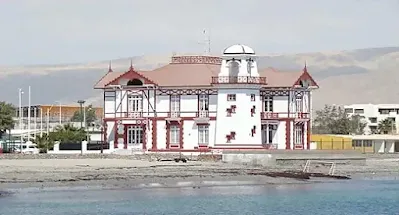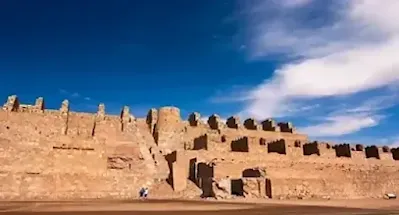Antofagasta, the capital of the region bearing the same name—also known as Chile’s "Second Region"—is a port city with an urban population of 377,690, making it the sixth most populous city in the country according to the 2024 census. It lies 1,368 km north of Santiago.
Economically, Antofagasta plays a key role in the mining sector, which has driven much of its recent growth. Often referred to as the "Pearl of the North," the city owes its importance to the region’s vast mineral wealth and its strategic position in northern Chile. Historically, Antofagasta was part of Bolivia until it was incorporated into Chile under the 1904 Treaty of Peace and Friendship.
- How to get there
- By Land: Antofagasta is well connected by road, with several bus lines departing from Santiago and other nearby cities. The region's main roads include Route 5 North (Pan-American Highway), Route 1 along the coast, Route 26 connecting the city to the airport and the interior, and Route B-400.
- By Air: Andrés Sabella Gálvez International Airport is located about 24 km north of downtown Antofagasta. Daily flights connect the airport with Santiago, Calama, La Serena, and Iquique.
- La Portada Natural Monument
La Portada (The Gateway) is one of the most iconic natural landmarks in Chile. It is located about 18 km north of Antofagasta along Route 1, followed by a 2 km detour on Route B-446.
This impressive natural arch was formed by the erosive action of the sea on the coastal rock and is surrounded by cliffs that rise up to 70 meters. The arch itself stands 43 meters high, 23 meters wide, and 70 meters long, situated very close to the shore. Its base, composed of volcanic rock, dates back approximately 150 million years, while the arch, made of sedimentary rock, is around 2 million years old. Interestingly, its structure resembles the now-collapsed Darwin's Arch in the Galápagos Islands.
From the viewpoint, visitors can enjoy sweeping views of the Pacific Ocean and observe a rich diversity of seabirds and marine life. However, due to the area's extreme aridity, vegetation is virtually absent.
- Plaza Colón: A Historic Heart of Antofagasta
Plaza Colón, also known as the Plaza de Armas, is one of the most iconic landmarks in Antofagasta. Located in the city center, this square is more than just a gathering place—it’s a site rich in history. It was here that Chilean troops landed in 1879 during the War of the Pacific, marking a turning point in the region's past.
The square also honors the foreign communities that contributed to the city's growth. One of its most striking features is the Clock Tower, a gift from the British community in 1911 to celebrate the centennial of Chilean independence. Inspired by the famous clock tower at Westminster in London, its design was scaled down due to regulations that prohibited any building from exceeding the height of the nearby Cathedral. Even so, the tower remains impressive, and its chimes echo the sound of London’s Big Ben.
Nearby stands the Kiosko de Retretas, also inaugurated in 1911 and donated by the Croatian community as a symbol of friendship with the local people. For many years, it hosted weekend performances by folk groups and military bands. Severely damaged by a major earthquake in 2007, the kiosk was fully restored and continues to be a beloved part of the square. Like other parts of Chile—especially the far south—Antofagasta welcomed a significant wave of Croatian immigrants in the late 19th and early 20th centuries.
Another notable monument is the sculpture Spain and America, donated by the resident Spanish community. It features two female figures symbolizing the two continents, accompanied by a condor with the Chilean coat of arms and a lion bearing the Spanish emblem.
Today, Plaza Colón remains a cultural and historical centerpiece of Antofagasta—a must-visit spot for anyone wanting to connect with the city’s diverse heritage.
- Ruinas de Huanchaca
Visiting the imposing stone structure of the Huanchaca Ruins for the first time is truly impressive, as it resembles an abandoned fortress from a long-lost civilization. However, this National Historical Monument, the oldest structure in the city and dating back to 1888, is actually the remains of a former silver smelting plant owned by a Bolivian mining company.
The foundry ceased operations permanently in 1902, and over 60 years later, the site was transferred by the Chilean government to the Universidad Católica del Norte. In 1974, it was officially declared a National Historical Monument. In 2007, the Fundación Ruinas de Huanchaca was created through a partnership between the Universidad Católica del Norte and Enjoy Antofagasta. That year, the site was included in a development plan to make it accessible to the public.
Today, the ruins are part of the Parque Cultural Ruinas de Huanchaca, located at 01606 Angamos Avenue, directly across from the Enjoy Antofagasta Casino. The cultural park also includes the Museo Desierto de Atacama, which features astronomical, geological, and archaeological exhibits, making it a major cultural and tourist center in the Antofagasta Region.
- Museo Regional de Antofagasta
The non-profit institution Museo de Antofagasta, is a historical, archaeological, and geological museum located at Av. José Manuel Balmaceda 2786, in the historic district of the city. It was established in 1964 under the auspices of the former Universidad del Norte, and in 1984 it was transferred to the Dirección de Bibliotecas, Archivos y Museos de Chile (DIBAM). Today, the museum features 12 permanent exhibition rooms and an auditorium for temporary exhibits, distributed across two buildings that once belonged to the customs and maritime authorities.
The museum's collection is grouped into the areas of bioanthropology, natural sciences, and social sciences, and comprises approximately 10,000 cultural items, including mineral, paleontological, and archaeological specimens related to the pre-Hispanic cultures of the coastal desert.
In addition, the museum holds an important photographic archive of about 1,500 images, capturing various aspects of Antofagasta society during the mid-20th century. There are also ethnographic artifacts, artworks, historical documents, and objects tied to the urban and mining history of the region—particularly furniture and a wide variety of tools used in the daily life and labor of the once-flourishing nitrate fields.
Other cultural institutions in Antofagasta include the Regional Library, located at George Washington St. 2623, in the heart of the city; the Municipal Theater, located at José Antonio de Sucre St. 433; and the Andrés Sabella Cultural Center, located at Juan José Latorre St. 2535.
Balneario Municipal and Other Beaches in Antofagasta
The Balneario Municipal is one of the most popular spots in Antofagasta and was the city's first artificial beach. Located in the southern part of the city, it stretches for about 130 meters and is suitable for swimming and various recreational activities related to the sea. One of its highlights is a floating platform located offshore, with a surface area of 100 m², capacity for up to 50 people, and resistance of up to 32 tons.
Surrounded by green areas, restaurants, and entertainment venues, the Balneario is especially appreciated in a city with a predominantly rocky coastline, making it one of the few urban beaches with calm waters suitable for swimming.
Other beaches fit for swimming in Antofagasta include Playa El Trocadero and Playa Paraíso, both artificial and located within the city. Playa La Chimba, Antofagasta’s fourth artificial beach, is under development in the northern sector and is expected to be inaugurated in 2025. Outside the urban area, the Juan López beach offers wide sandy beaches, clear waters, and scenic coastal views.
Visitors to Antofagasta can enjoy swimming, sunbathing, beach sports, and access to nearby cafes, restaurants, and picnic areas.
Also worth mentioning is Playa Las Losas, a 1.4 km-long natural beach situated between La Portada and Playa La Rinconada. Known for its soft white sand and volcanic rock formations, it provides a picturesque coastal landscape and is ideal for relaxation, photography, and shoreline fishing—although not officially authorized for swimming.
Finally, Playa Blanca is another artificial beach located south of the city. Though not officially listed as a beach authorized for swimming by Chile’s maritime authorities, it is a popular weekend destination due to its calm waters, sandy area, and nearby food stalls. Visitors should be cautious when swimming, as it lacks formal lifeguard services.
- Mercado Municipal
It is also notable for its elegant neoclassical architecture, making it one of the most beautiful markets in the country.
- Old railway station Antofagasta-Bolivia
From Plaza Colón, walk along Simón Bolívar Street toward the coast, and you'll spot an old building on the right with green walls, wooden windows, and balconies. This is the former station of the Antofagasta to Bolivia Railway (FCAB), built in 1888.
In 1981, the building, along with its platforms and administrative offices, was declared a National Monument in the category of Historical Monument. Today, the property still belongs to the same company, which has undergone several name changes and is now called FCAB Ferrocarril de Antofagasta.
- Tropic of Capricorn Monument
An outstanding place to visit in Antofagasta is the Tropic of Capricorn Monument, a landmark located where this parallel crosses, north of the city, in front of the Andres Sabella Airport.
- "The Hand of the Desert" sculpture
75 Km. south of the city, in the middle of the Atacama Desert and next to Route 5 (Panamerican Highway), you will find this remarkable work of the Chilean sculptor Mario Irarrazabal. Today, the eleven meter high reinforced concrete sculpture has become one of the tourist icons of the so-called "Second Region of Chile".
- Astronomy Tours
Northern Chile—divided into the regions known as Norte Grande (Big North) and Norte Chico (Small North)—is internationally recognized as one of the best places on Earth to observe the night sky. Thanks to its exceptionally clear and unpolluted atmosphere, several major scientific institutions have chosen Chile to host some of the most important astronomical observatories in the world.
Nearly 40% of the global astronomical observation capacity is currently located in Chile, and that figure is expected to grow even further. Several groundbreaking facilities are underway, including the Extremely Large Telescope (ELT), the Giant Magellan Telescope (GMT), and the long-awaited Vera C. Rubin Observatory. In the Antofagasta Region, the Atacama Observatory (TAO), built by the University of Tokyo, is now the highest observatory on the planet, located at an altitude of 5,640 m a.s.l. These projects continue to position Chile as a global leader in astronomy and space science.
Astronomical tourism is a growing activity that draws visitors from all over the world. Guided tours, typically lasting around three hours, allow tourists to observe stars, planets, constellations, galaxies, nebulae, the Sun, and the Moon through modern, state-of-the-art telescopes.
While the Coquimbo Region is home to the largest number of observatories in Chile, the Antofagasta Region stands out for the scientific importance of its facilities—particularly Cerro Paranal, home to the Very Large Telescope (VLT). Located 130 km south of Antofagasta, the VLT is considered the most advanced optical instrument on the planet. Operated by the European Southern Observatory (ESO), it is the largest installation of its kind in the world and one of the most productive observatories globally, with more than one scientific publication generated per day from its research.
Another key facility is ALMA (Atacama Large Millimeter/submillimeter Array), the world’s largest radio telescope, composed of 66 antennas measuring 7 and 12 meters in diameter. On nearby Cerro Armazones, the ELT is being built and will soon become the largest optical observatory ever constructed.
Several major observatories allow public visits through online reservation systems, though bookings must often be made months in advance due to high demand.
For those looking for more accessible experiences, local tour operators also offer visits to smaller but equally fascinating observatories. These include Paniri Caur in Chiu-Chiu, 35 km from the city of Calama; the Ahlarkapin Astronomical Observatory, operated by local residents of the archaeological town of San Pedro de Atacama, and the Licanantay Ethno-Astronomical Observatory, also in San Pedro—among others.
- Salar de Atacama (Atacama Salt Flat)
If you're visiting The Pearl of the North, a trip to the Salar de Atacama is a must. This vast salt flat, one of the largest lithium reserves in the world, is a major attraction near Los Flamencos National Reserve.
The largest salt flat in Chile lies just over 300 km east of Antofagasta and 55 km south of San Pedro de Atacama, the nearest city. Scattered across its dazzling white landscape are several bodies of water formed by erosion, the most notable being the Chaxa Lagoon. Its shores are home to flora specially adapted to the saline soil and harsh desert climate.
The region’s fauna includes flamingos—after which the National Reserve is named—as well as other bird species such as Andean geese (piuquenes), rheas, and ducks. Mammals like guanacos and vicuñas also inhabit the area, living alongside their domesticated camelid relatives: llamas and alpacas.
Tours depart from both Antofagasta and San Pedro de Atacama. Find the location of the Salar de Atacama HERE.
- Other must-sees when visiting the Antofagasta Region
- San Pedro de Atacama, the small town of San Pedro de Atacama has become one of the most popular tourist destinations in Chile, for the various excursions that will take you to know its Andean landscapes, native flora and fauna and archaeological wealth.
- The Gustavo Le Paige Archaeological Museum, houses rich archaeological and ethnographic collections recovered by the Belgian Jesuit priest G. Le Paige (1903-1980), with the largest collection of archaeological pieces of the Atacameño culture (about 380,000).
- El Tatio Geysers, a magnificent 10 km2 geothermal field of volcanic origin where water and vapor spring up with force from the depths of the earth. The distance from Antofagasta is 390 km. and from San Pedro de Atacama 78 km.
- Valle de la Luna (The Valley of the Moon), one of the most barren spots in the Atacama Desert, but certainly, one of the favorite places to visit in this part of northern Chile. It is located 13 km W of San Pedro de Atacama and 110 km SE from rhe mining city of Calama.
 |
| Image: Chile del Ayer |
- Mejillones, a town and commune located 65 km. north of Antofagasta. Despite being a small city (estimated population of 14,000 inhabitants), the Mejillones port complex has acquired great importance since large mining companies have decided to concentrate their operations here for reasons of proximity, geography and climate.
- The commune also features sights and tourist attractions worth mentioning, such as the Capitania de Puerto (Mejillones Harbor Master's Office Building), an iconic landmark of the town, built in 1910; the Corazón de Maria Parish, built between 1906 and 1908, with Oregon pine used for the entire construction; the beach of Mejillones, in a beautiful bay, considered one of the best places for bathers in northern Chile; the small Museo Historico Natural, at 110 Francisco Pinto street, a museum with 5 exhibition rooms featuring relevant archaeological, historical and biological information of the area.
- Hornitos, town and beach, located 88 km. North of Antofagasta, near the town of Mejillones, Hornitos is always mentioned as one of its important attractions for being one of the most beautiful beaches in northern Chile, with a coastline of 5 Km. of fine sands and little waves, nestled at the feet of the coastal cliffs, typical of the region. The good waves at Hornitos make it an excellent destination for surfers and water sports enthusiasts.






Comments
Post a Comment